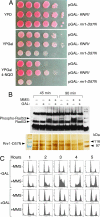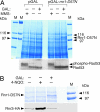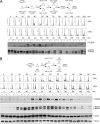Constitutively high dNTP concentration inhibits cell cycle progression and the DNA damage checkpoint in yeast Saccharomyces cerevisiae
- PMID: 17227840
- PMCID: PMC1783093
- DOI: 10.1073/pnas.0610585104
Constitutively high dNTP concentration inhibits cell cycle progression and the DNA damage checkpoint in yeast Saccharomyces cerevisiae
Abstract
In eukaryotic cells the concentration of dNTP is highest in S phase and lowest in G1 phase and is controlled by ribonucleotide reductase (RNR). RNR activity is eliminated in all eukaryotes in G1 phase by a variety of mechanisms: transcriptional regulation, small inhibitory proteins, and protein degradation. After activation of RNR upon commitment to S phase, dATP feedback inhibition ensures that the dNTP concentration does not exceed a certain maximal level. It is not apparent why limitation of dNTP concentration is necessary in G1 phase. In principle, dATP feedback inhibition should be sufficient to couple dNTP production to utilization. We demonstrate that in Saccharomyces cerevisiae constitutively high dNTP concentration transiently arrests cell cycle progression in late G1 phase, affects activation of origins of replication, and inhibits the DNA damage checkpoint. We propose that fluctuation of dNTP concentration controls cell cycle progression and the initiation of DNA replication.
Conflict of interest statement
The authors declare no conflict of interest.
Figures





References
-
- Reichard P. Annu Rev Biochem. 1988;57:349–374. - PubMed
-
- Elledge SJ, Zhou Z, Allen JB. Trends Biochem Sci. 1992;17:119–123. - PubMed
-
- Nordlund P, Reichard P. Annu Rev Biochem. 2006;75:681–706. - PubMed
-
- Mathews CK. FASEB J. 2006;20:1300–1314. - PubMed
-
- Thelander L, Reichard P. Annu Rev Biochem. 1979;48:133–158. - PubMed
Publication types
MeSH terms
Substances
Grants and funding
LinkOut - more resources
Full Text Sources
Other Literature Sources
Molecular Biology Databases

